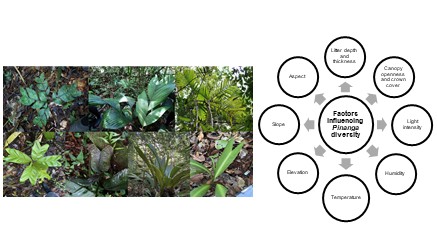ASSESSMENT OF SEEDLING ABUNDANCE, SURVIVAL AND GROWTH OF TWO DIPTEROCARP SPECIES IN PEAT SWAMP FORESTS OF BRUNEI DARUSSALAM
Downloads
Dryobalanops rappa Becc. and Shorea albida Sym. are Bornean endemics of high conservation value and increasingly threatened by anthropogenic disturbances. In-situ study of seedling abundance and growth performance of these Dipterocarp species was conducted in two selected peat swamp forests of Brunei Darussalam, following a mast fruiting event in March–May 2014. Within six 6 x 6 m plots at each forest site, D. rappa seedlings at the Anduki peat swamp forest and S. albida seedlings at the Badas peat swamp forest were measured for abundance at the initial census in September 2014, as well as survival and relative growth rates (RGR) after a period of 5 months, with the final census in February 2015. We found significantly higher seedling abundance for D. rappa (1885 ± 208) than S. albida (160 ± 71). Significantly higher percentage survival was recorded for D. rappa seedlings (90.8 ± 2.2%) in comparison to S. albida seedlings (81.7 ± 2.2%). S. albida seedlings (0.24 ± 0.02 mm mm-1 month-1) showed significantly greater RGR in stem diameter than D. rappa seedlings (0.18 ± 0.02 mm mm-1 month-1), however, there were no significant differences in the RGRs based on seedling height, leaf number and biomass between D. rappa and S. albida seedlings. In terms of seedling abundance and percentage survival, D. rappa seedlings appeared to be more successful in regeneration and may potentially be used for rehabilitation of degraded tropical peat swamps and other forest types. Our results suggested that greater conservation efforts of peat swamps must be made to protect the Bornean endemic plant species, in particular S. albida.
Downloads
Authors who publish with this journal agree with the following terms:
- Authors retain copyright and grant the journal right of first publication, with the work 1 year after publication simultaneously licensed under a Creative Commons attribution-noncommerical-noderivates 4.0 International License that allows others to share, copy and redistribute the work in any medium or format, but only where the use is for non-commercial purposes and an acknowledgement of the work's authorship and initial publication in this journal is mentioned.
- Authors are able to enter into separate, additional contractual arrangements for the non-exclusive distribution of the journal's published version of the work (e.g., post it to an institutional repository or publish it in a book), with an acknowledgement of its initial publication in this journal.
- Authors are permitted and encouraged to post their work online (e.g., in institutional repositories or on their website) prior to and during the submission process, as it can lead to productive exchanges, as well as earlier and greater citation of published work (See The Effect of Open Access).




























